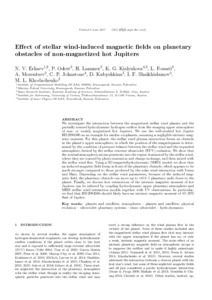Показать сокращенную информацию
Effect of stellar wind induced magnetic fields on planetary obstacles of non-magnetized hot Jupiters
| Автор | Erkaev, N. V. | |
| Автор | Odert, P. | |
| Автор | Lammer, H. | |
| Автор | Kislyakova, K. G. | |
| Автор | Fossati, L. | |
| Автор | Мезенцев, Александр Владимирович | |
| Автор | Johnstone, C. P. | |
| Автор | Kubyshkina, D. I. | |
| Автор | Shaikhislamov, I. F. | |
| Автор | Khodachenko, M. L. | |
| Дата внесения | 2018-02-07T07:27:23Z | |
| Дата, когда ресурс стал доступен | 2018-02-07T07:27:23Z | |
| Дата публикации | 2017-10 | |
| Библиографическое описание | Erkaev, N. V. Effect of stellar wind induced magnetic fields on planetary obstacles of non-magnetized hot Jupiters [Текст] / N. V. Erkaev, P. Odert, H. Lammer, K. G. Kislyakova, L. Fossati, Александр Владимирович Мезенцев, C. P. Johnstone, D. I. Kubyshkina, I. F. Shaikhislamov, M. L. Khodachenko // Monthly Notices of the Royal Astronomical Society. — 2017. — Т. 470 (№ 4). — С. 4330-4336 | |
| ISSN | 00358711 | |
| URI (для ссылок/цитирований) | https://academic.oup.com/mnras/article-lookup/doi/10.1093/mnras/stx1471 | |
| URI (для ссылок/цитирований) | https://elib.sfu-kras.ru/handle/2311/69720 | |
| Аннотация | We investigate the interaction between themagnetized stellarwind plasma and the partially ionized hydrodynamic hydrogen outflow from the escaping upper atmosphere of non-magnetized or weakly magnetized hot Jupiters. We use the well-studied hot Jupiter HD 209458b as an example for similar exoplanets, assuming a negligible intrinsic magnetic moment. For this planet, the stellar wind plasma interaction forms an obstacle in the planet’s upper atmosphere, in which the position of the magnetopause is determined by the condition of pressure balance between the stellar wind and the expanded atmosphere, heated by the stellar extreme ultraviolet radiation.We show that the neutral atmospheric atoms penetrate into the region dominated by the stellar wind, where they are ionized by photoionization and charge exchange, and then mixed with the stellar wind flow. Using a 3D magnetohydrodynamic (MHD) model, we show that an induced magnetic field forms in front of the planetary obstacle, which appears to be much stronger compared to those produced by the solar wind interaction with Venus and Mars. Depending on the stellar wind parameters, because of the induced magnetic field, the planetary obstacle can move up to ≈0.5–1 planetary radii closer to the planet. Finally, we discuss how estimations of the intrinsic magnetic moment of hot Jupiters can be inferred by coupling hydrodynamic upper planetary atmosphere andMHDstellar wind interaction models together with UV observations. In particular, we find that HD 209458b should likely have an intrinsic magnetic moment of 10–20 per cent that of Jupiter. | |
| Тема | hydrodynamics –MHD– planets and satellites: atmospheres – ultraviolet: planetary systems | |
| Название | Effect of stellar wind induced magnetic fields on planetary obstacles of non-magnetized hot Jupiters | |
| Тип | Journal Article | |
| Тип | Journal Article Postprint | |
| Страницы | 4330-4336 | |
| ГРНТИ | 41.17 | |
| Дата обновления | 2018-02-07T07:27:23Z | |
| DOI | 10.1093/mnras/stx1471 | |
| Институт | Политехнический институт | |
| Подразделение | Кафедра прикладной механики | |
| Журнал | Monthly Notices of the Royal Astronomical Society | |
| Квартиль журнала в Scopus | Q1 | |
| Квартиль журнала в Web of Science | Q1 |

